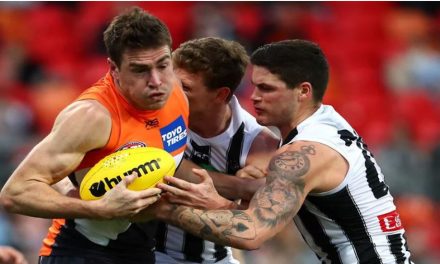Promotion/relegation is the cornerstone of European soccer, and the AFL might have to introduce it some time soon too. Photo: GETTY IMAGES
Tasmania won’t go away, and nor should it.
If ever a state or territory could make a case that it “deserves” an AFL team of its own, the Apple Isle is it.
Poll after poll by mainstream media outlets, along with the overwhelming sentiment of talkback radio callers and digital forums, indicate that the majority of football fans agree.
A 19th AFL club would likely bring about a 20th – in order to avoid the dreaded bye, and perhaps that’s part of the hold-up in decision-making around Tasmania at AFL House – so let’s call that club “Darwin” for now and beat the “truly national competition” drum later.
The huge financial impact of the coronavirus pandemic and significant cost of setting up new clubs (see GWS and Gold Coast) suggests the next round of expansion is still at least a few years away. It might be the better part of a decade, or more.
Stadiums, facilities and player acquisition, not to mention a funding model that works for all major stakeholders, are among the multitude of issues that need to be worked out.
But the groundswell of support for Tasmania should win out eventually. If we accept that as a fait accompli, then there is another issue that needs addressing.
And here is a major opportunity, presented by AFL expansion to 20 clubs, to fix something that has been broken since the introduction of West Coast and Brisbane more than 30 years ago: the fixture.
Some say there’s already enough “division” in the AFL, but maybe we actually need more “Divisions”? Two of them, in fact. Hear me out.
By splitting the 20-team competition into two Divisions with an annual promotion and relegation system, you could generate something that clubs, fans and broadcasters all crave far more of: matches with relevance.
Finding a way to add genuine meaning to more matches is a problem already weighing heavily on the decision-makers at AFL House.
It is precisely why some have raised the prospect of a 10-team finals series – featuring more than half the competition – and have attempted to sell the concept via a clumsy adaptation of the American term “wildcard”.
Two divisions, two finals series and, most importantly, promotion and relegation between Division One and Two would provide meaning to a host of matches that would otherwise have nothing riding on them – especially in the back half of the season when several clubs’ top-eight chances are normally shot a long way out from the finals.
PLEASE HELP US CONTINUE TO THRIVE BY BECOMING AN OFFICIAL FOOTYOLOGY PATRON. JUST CLICK THIS LINK.
It could also fix what currently must be the most inequitable fixture in professional sport the world over.
Here’s how:
• Split the teams into Division One and Division Two, consisting of 10 teams each. If the expansion date is 2030, for example, the top 10 teams from 2029 will enter the first season under the new model in Division One.
• Tasmania and “Darwin” enter the competition in Division Two.
• Home-and-away matches against each of the nine rivals in your Division over 18 rounds. It is a fair and rigid formula for the fixture, as opposed to the current malleable method of determining which clubs gets double-up games against which opposition.
• A five-team finals series in each Division to decide the respective champions. Clearly, the ultimate aim remains to win the AFL premiership as the winner of the Division One grand final.
• Annual promotion and relegation between the divisions, with four clubs going up and four going down. Clubs are unlikely to remain mired in Division Two for too long with that much movement between the tiers.
• Very few clubs will be out of finals contention in their Division towards the end of each season, with half the clubs getting in. It means more matches will have relevance throughout the home-and-away season than they do at present.
• As an equalisation measure, Division Two clubs that miss out on finals (and the chance for promotion) are given extra draft picks that year to help them climb the ladder. It could mean another pick at the end of the first round.
• There’s no incentive for Division Two clubs to tank for those draft picks when playing finals and fighting for promotion is a far more desirable outcome.
Some readers are no doubt shaking their heads and muttering something about Divisions not being part of footy culture. Perhaps they’re dismissing promotion and relegation as “a soccer thing”.
That’s not exactly true though, is it? Many amateur Australian Rules competitions around the country have been operating on the same model of promotion and relegation for decades.
It works well for those competitions, but the AFL hasn’t yet had enough competing clubs to warrant using that system at the top level. The 19th and 20th clubs would change that.
And when it comes to the inequitable fixture and a litter of irrelevant matches each season, why shouldn’t the AFL take aim at multiple birds with one stone?











I can’t imagine AFL CEO Gill McLachlan and their media sponsors ever being supportive of promotion and relegation in the AFL for several reasons (because money talks). However, a long-term expansion to 24 clubs with two 12-club divisions (and an equal 22-round home and away season) could include strategic locations such as Canberra and Cairns (in addition to Tasmania and Darwin), with their own identities, contributions and history.
Of all the arguments put forward about conferences or divisions, this is probably the best. However, I have the following queries
– Is there a need for divisions when we go to 20 teams? Each team just plays the other once and then maybe have a 10 team finals series.
– We have byes now, so not sure why it would be an issue having a natural bye when the 19th team comes in. Although probably not great for the team that gets the bye in the first round.
– 4 clubs being promoted and relegated seems too many. Not sure how much incentive there would be to win the 2nd division premiership. The top 3 teams at the end of the home and away rounds would already know that they are being promoted, so might not care that much that they are the premiers. Could take a few seasons for the care factor to come in.
– Will it hit smaller clubs financially if they don’t get to play the big clubs for a number of seasons in a row.
I agree, Steve, there’s some real merit in this proposal. I too think that 4 teams going up and down is too many. It should probably only be the top team/bottom team or at worst, top/bottom 2.
Big clubs won’t necessarily be in the top tier, if you think about Carlton, Essendon, Melbourne, even the Pies in the second half of the comp over the past decade. Also, if interest remains in the season right through to the end (either pushing for finals or avoiding relegation!), the fans will turn up or turn on the TV to watch.
it will mean the end of the blockbuster concept, which I don’t think is necessarily a bad thing
How about the top div 2 team is automatically promoted and teams 2-5 play a finals series in the old final 4 format for the second promotion spot?